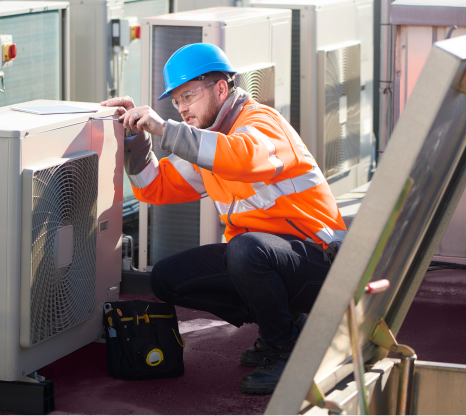
"Comprehensive AC maintenance" refers to a thorough and all-encompassing approach to the regular upkeep and care of an air conditioning system. It involves a range of tasks and inspections to ensure the optimal performance, efficiency, and longevity of the AC unit.
Here are some key aspects typically covered in comprehensive AC maintenance:

The maintenance process begins with a detailed cleaning of various components of the AC system, including the filters, coils, and condenser. This helps remove dust, dirt, and debris hindering the system's efficiency. Additionally, the technician inspects these components for any signs of damage or wear that may require repair or replacement.
Proper lubrication of moving parts, such as motors, fans, and bearings, is essential to reduce friction and ensure smooth operation. During maintenance, the technician checks the lubrication levels and applies oil or grease to prevent excessive wear and tear.
The refrigerant level and pressure are examined to ensure they are within the manufacturer's recommended range. Insufficient or excessive refrigerant can decrease cooling capacity and increase energy consumption. The technician will recharge the system with the appropriate amount of refrigerant if necessary.
The electrical connections, wiring, and controls of the AC unit are inspected for any loose connections, frayed wires, or malfunctioning components. Faulty electrical systems can pose safety risks and cause system inefficiency or breakdowns.
The accuracy of the thermostat is verified and calibrated if necessary. A properly calibrated thermostat ensures accurate temperature control and prevents the system from running unnecessarily, saving energy and reducing wear on the equipment.
The airflow through the system is checked to ensure it is unrestricted and adequate. The technician examines the ductwork, vents, and registers for blockages or leaks that can impede airflow and affect cooling performance.
The condensate drain line is inspected and cleared of any obstructions, such as dirt, algae, or debris. A clogged drain line can lead to water leakage and potential damage to the AC unit or surrounding areas.
After completing the maintenance tasks, the technician assesses the overall performance of the AC system. They may measure temperature differentials, monitor system operation, and make necessary adjustments to optimize performance and energy efficiency.
Regular comprehensive AC maintenance is recommended at least once a year to keep the system running smoothly and efficiently. It helps identify and address minor issues before they escalate into major problems, prolonging the lifespan of the equipment and ensuring consistent cooling comfort throughout the year.
Introduction
Air conditioning systems have become an essential component of our modern lives, providing comfort and relief from sweltering heat. To ensure their optimal performance and longevity, regular maintenance is crucial. Comprehensive AC maintenance involves a series of tasks and checks that go beyond simple filter cleaning. This article aims to delve into the importance of comprehensive AC maintenance, outlining its key components and benefits.
Regular inspection and cleaning are fundamental aspects of comprehensive AC maintenance. A trained technician should conduct a thorough examination of the system, including the air handler, condenser unit, evaporator coil, and ductwork. This inspection helps identify any underlying issues or potential problems, such as leaks, blockages, or damaged components.
Cleaning the various parts of the system is equally important. Over time, dust, debris, and other contaminants accumulate, reducing the system's efficiency and potentially leading to health hazards. Cleaning the condenser coils, evaporator coils, filters, and ducts ensures uninterrupted airflow, optimal heat transfer, and improved indoor air quality.
The refrigerant in an AC system is responsible for absorbing and releasing heat, playing a crucial role in cooling the indoor space. A comprehensive maintenance routine includes checking the refrigerant levels and detecting any leaks. Low refrigerant levels can strain the system, leading to reduced cooling capacity and increased energy consumption. Identifying and repairing refrigerant leaks is vital to prevent further damage and maintain the system's efficiency. Checkout Our Air Conditioning Sydney Units
The electrical components of an AC system, such as capacitors, relays, and motors, are susceptible to wear and tear. Faulty electrical components can lead to system malfunctions, increased energy consumption, and even complete system failure. During comprehensive maintenance, these components should be inspected for signs of damage, corrosion, or loose connections. Any issues should be addressed promptly to avoid more significant problems down the line.
The thermostat serves as the control center for the AC system, regulating the temperature and ensuring optimal comfort. However, a poorly calibrated thermostat can result in temperature inaccuracies and inefficient cooling. As part of comprehensive AC maintenance, the technician should evaluate and calibrate the thermostat, ensuring it accurately reflects the desired temperature and operates efficiently.
Ductwork plays a crucial role in distributing conditioned air throughout the building. Over time, ducts can develop leaks, cracks, or blockages, compromising the system's efficiency and causing inconsistent cooling. A comprehensive AC maintenance plan includes a thorough assessment of the ductwork. Technicians will inspect for leaks, seal any gaps, and clean or remove any obstructions, ensuring proper airflow and minimizing energy waste.
The fans and blowers within an AC system are responsible for circulating conditioned air. Accumulated dirt and debris can obstruct their operation, reducing airflow and overall performance. During comprehensive maintenance, the fans and blowers should be cleaned and lubricated, ensuring smooth operation and optimal air circulation.
Regular maintenance ensures that the AC system operates at its peak efficiency, reducing energy consumption and utility costs. By addressing issues such as refrigerant leaks, dirty filters, and faulty electrical components, the system can operate optimally, delivering efficient cooling while consuming less energy.
Neglecting AC maintenance can lead to premature system failure. Comprehensive maintenance helps identify and rectify minor issues before they escalate, extending the lifespan of the system. Regular cleaning, lubrication, and inspection reduce wear and tear, allowing the AC system to perform reliably for years to come.
ACG Air Conditioning Sydney
182A Canterbury Rd, Canterbury NSW 2193, Australia
Phone: +61 2 8021 3735
https://airconditioningguys.com.au/specials/
https://goo.gl/maps/qMRpabiWjarAGiSq8
Contact ACG Now & Experience the Difference